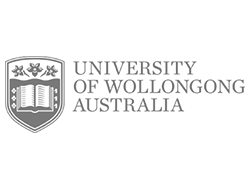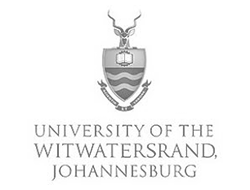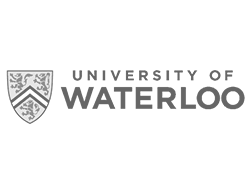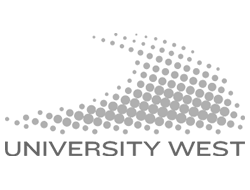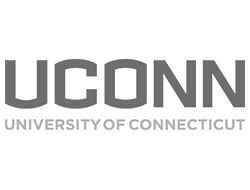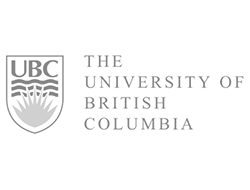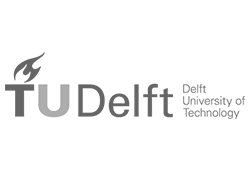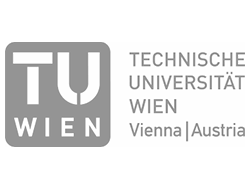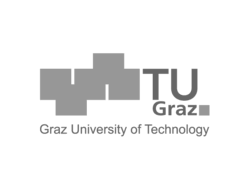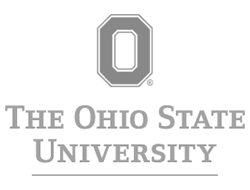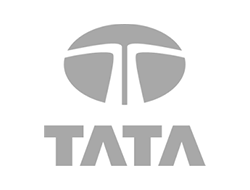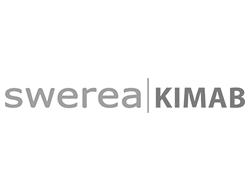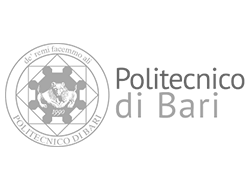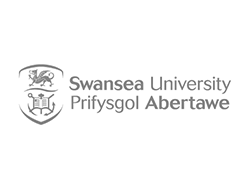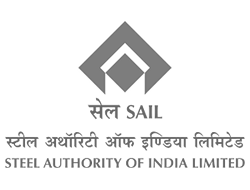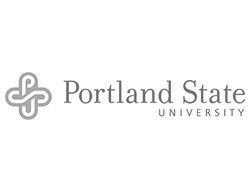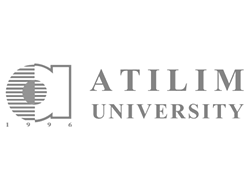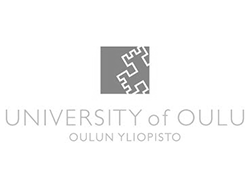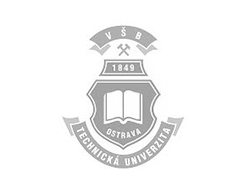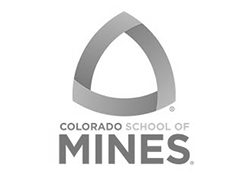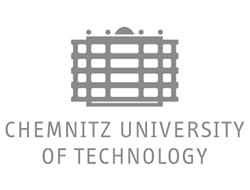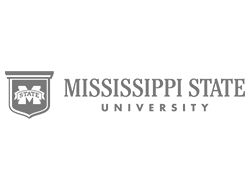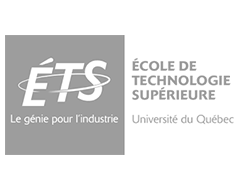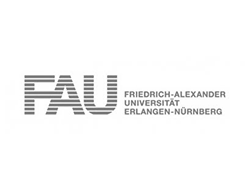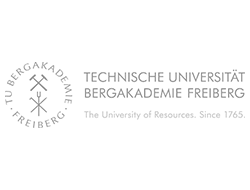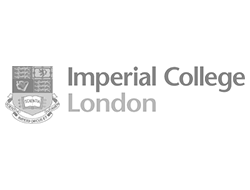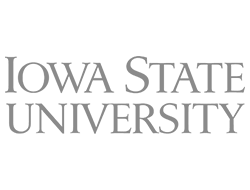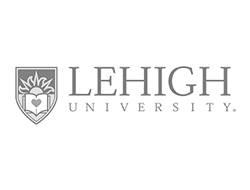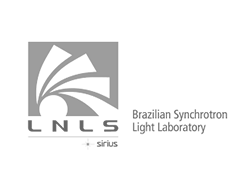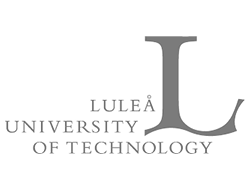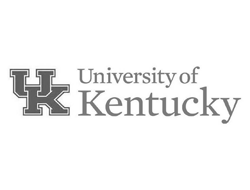Gleeble WEbinar Series
An interactive online meeting place for researchers to discuss how the Gleeble can help solve material challenges.
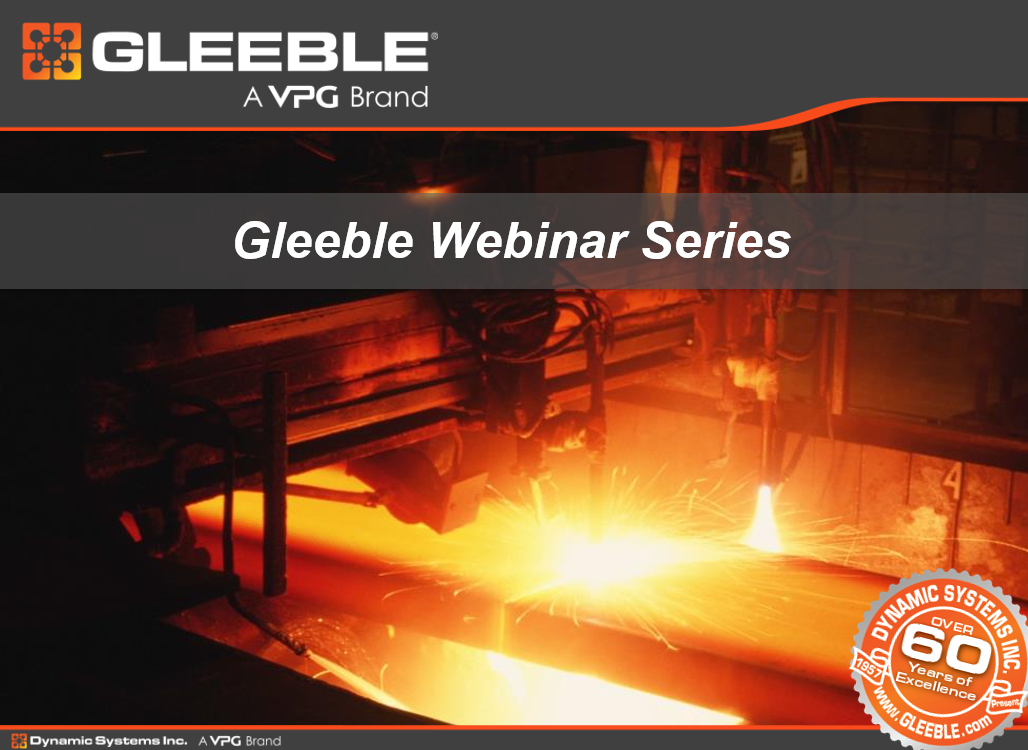 |
To better support and empower Gleeble users, DSI is hosting a series of interactive Gleeble discussions. We invite you to join us. Webinars focus on different topics, ranging from specific training and best practices to applications and research presentations. Our goal is to keep each meeting under an hour with a short presentation by one of our experts, followed by Q&A if time permits. We look forward to connecting with you soon. If you have any questions, or ideas for topics that you would like covered during a webinar, please don't hesitate to contact us. (info@Gleeble.com) |
Webinar Recordings:
| Episode # | Date | Topic | Link |
| Episode 53 | Thursday June 15, 2023 |
Physical Testing, Numerical Models and Real Processes: Making the Multi-Scale Connection Presented By: Fernando Okigami Abstract: Physical tests performed in Gleeble machines provide powerful insight into specific conditions of materials and processes. Data obtained in such tests can be augmented by leveraging finite-element models to understand further the implications of the thermomechanical process. The true end goal of both physical and numerical representations is to design better products and robust manufacturing processes. In this webinar we will show how to make this multi-scale connection between the various stages and drawing important conclusions from the augmentation process. |
 |
| Episode 52 | Thursday, April 13, 2023 | Cleavage Fracture in Heat-Affected Zones of High Strength Steel
Presented by: Dr. Virgínia Bertolo and Dr. Quanxin Jiang Abstract: High strength steels are widely used for structural applications, where a combination of excellent strength and ductile-to-brittle transition (DBT) properties are required. However, such a combination of high strength and toughness can be deteriorated in the heat-affected zone (HAZ) after welding. This work aims to develop a relationship between microstructure and cleavage fracture in the most brittle areas of welded S690 high strength structures: coarse-grained and intercritically reheated coarse-grained HAZ (CGHAZ and ICCGHAZ). Gleeble thermal simulations were performed to generate three microstructures: CGHAZ and ICCGHAZ at 750 and 800 °C intercritical peak temperatures. Their microstructures were characterised, and fracture properties were investigated at –40 °C, where cleavage is dominant. Results show that despite the larger area fraction of martensite-austenite (M-A) constituents in ICCGHAZ 750 °C, the CGHAZ is the zone with the lowest fracture toughness. Although M-A constituents are responsible for triggering fracture, their small size (less than 1 µm) results in local stress that is insufficient for fracture. Crack propagation is found to be the crucial fracture step. Consequently, the harder auto-tempered matrix of CGHAZ leads to the lowest fracture toughness. During propagation, M- A constituents with internal sub-structures, which have high kernel average misorientation and high-angle boundaries, are observed to deflect and arrest the secondary cracks. As a result, multiple pop-ins in load-displacement curves during bending tests are observed for the investigated HAZs. Based on the experimental results, a microstructure-based method with input from finite element analysis is used to model the cleavage behavior of the HAZ. It is found that the resistance to micro-crack propagation is more effective in heat-affected zones, which can be explained by the residual compressive stress in M-A constituents. This study informs the trade-off between microstructural parameters (e.g., M-A constituents and inclusions) and helps a designer choose a process for controlling cleavage toughness. Click here to download a PDF of the presentation. |
 |
| Episode 51 | Thursday, August 4, 2022 | The Application of Hot Deformation Processing in Hybrid Metal Additive Manufacturing using Gleeble 563 and Simu-Mat 1.0 Presenter: Clodualdo Aranas Jr., PhD, PEng Associate Professor, Mechanical Engineering Department, University of New Brunswick Abstract: This webinar demonstrates the application of thermomechanical processing and material constitutive modeling to assess the mechanical performance of the additively manufactured M789-N709 hybrid alloy system for tool and die application. The hybrid material was fabricated by depositing M789 steel on wrought N709 steel by means of the laser powder bed fusion (LPBF) technique. Extensive heat treatment and microstructural analysis were carried out to analyze the compatibility of the alloy combination. To model the high-temperature response of the material, hot compression tests were performed on both M789 and N709 steels using the Gleeble 563. Then, phenomenological-, physical-, and artificial neural network-based constitutive material models were then established utilizing Simu-Mat 1.0. The material models established in this work can now be employed to estimate the response of the hybrid alloy system at elevated temperatures. Click here to download a PDF of the presentation. |
 |
| Episode 50 | Thursday, May 26, 2022 |
Evidence of Dynamic Transformation Under Tensile Tests Using a Gleeble Machine Coupled with In-Situ X-Ray Diffraction Presenter: Prof. Samuel Filgueiras Rodrigues, PhD. Abstract: When austenite is deformed in the single austenite phase field, a partial amount of this phase transforms dynamically into ferrite by a displacive mechanism. After releasing the applied loading, some amount of this induced formed ferrite retransforms back into the stable austenite by a diffusional process. This influences the machine loads reflecting in its decreasing under isothermal conditions and does not increase as rapidly as expected when continuous cooling thermomechanical processes are employed. Physical process simulations by means of tensile tests in a customized Gleeble machine simulation system equipped with a synchrotron light X-ray beam (12 keV) under isothermal conditions were carried out on an Nb X-70 steel. The flow stress-strain behavior indicates that dynamic transformation was taking place during straining. The presence of ferrite peaks obtained the X-ray diffraction results was evident during deformation and vanished after isothermal holding. Previous researches have been shown that ferrite can be formed due to the applied strain and increases its volume fraction as the deformation continuous to be increased. It is only possible to form such a softer phase when the driving force for dynamic transformation is higher than the total free energy barrier which prevents its formation. This barrier consists of the free energy difference between austenite and ferrite summed to the lattice dilatation work and shear accommodation work. The presence of Nb retards the retransformation of the ferrite into austenite due to pinning and/or solute drag effects. Moreover, holding times after deformation increases the amount of austenite available for microstructure control during rolling. This phenomenon mechanism can be used as an advantage to design improved manufacturing schedules. Click here to download a PDF of the presentation. |
 |
| Episode 49 | Thursday, April 14, 2022 |
Evaluation of the Hot Ductility and Microstructure Formation of Steel During Continuous Casting Processes Simulated in a Gleeble 3500 Thermomechanical Simulator Presenter: Alyssa Stubbers Abstract: Phase transformation and precipitation in steel during continuous casting may cause low ductility behavior that can lead to cracking and other quality concerns during steel production. University of Kentucky uses a Gleeble 3500 Thermomechanical Simulator to conduct physical simulations of casting conditions to measure mechanical behavior and in-situ analysis of phase transformation that contribute to low ductility behaviors. Use of the Gleeble in these applications has provided an increased ability to precisely model steel casting systems and develop a greater understanding of microstructure formation mechanisms during initial phases of steelmaking. Click here to download a PDF of the presentation. |
 |
| Episode 48 | Thursday, December 2, 2021 |
Non-Contact Deformation Measurements at Extreme Temperatures Using Ultraviolet Digital Image Correlation (UV-DIC) Presenter: Prof. Ryan Berke, Utah State University Abstract: Digital Image Correlation (DIC) uses cameras to measure surface displacements and strains by comparing images collected before and after deformation. Compared to strain gauges, DIC has the advantages that it records full-field deformation, is non-contacting, and can be used at any time or length scale depending on which cameras and lenses are used. In the case of extreme temperature measurements, it has the added benefit that it can be performed at temperatures well above which strain gauges become damaged. However, when performing DIC at extreme temperatures, care must be taken to shield the camera sensor against light emitted when a specimen glows white-hot. The emitted light is known to be brighter at longer wavelengths (e.g. red or infrared) and can therefore be screened using optical bandpass filters at shorter wavelengths (e.g. blue or ultraviolet). In this talk, we will discuss the relative importance of lighting and camera sensitivity when integrating DIC into Gleeble-style measurements at temperatures of up to at least 1600°C. Click here to download a PDF of the presentation. |
 |
| Episode 47 | Thursday, November 4, 2021 |
Physical Simulation Technology at Ansteel using the Gleeble as an Efficient Platform for Material Research Presenter: Dr. Baochun Zhao Dr. Baoshun Zhao from the Iron and Steel Research Institute of Angang Group reviews how Ansteel utilizes their various Gleeble systems to simulate and optimize their manufacturing processes. The Gleeble is used to develop new products as well as develop new processes including continuous casting, reheating, optimizing mill capacity, rolling and cooling. Ansteel operates three Gleeble systems including a Gleeble 1500 installed in the 1980s as well as two much newer Gleeble 3800 systems equipped with a Hydrawedge and MaxStrain. Ansteel is also utilizing an Induction Heating system on one of the Gleeble 3800 units. Dr. Zhao reviews five case studies where the Gleeble was involved in solving real-world challenges. Click here to download a PDF of the presentation. |
 |
| Episode 46 | Thursday, October 21, 2021 |
Coupling Welding Experiments with Gleeble Thermomechanical Simulations to Probe Weldability in Advanced Stainless Steels The response of engineering alloys to welding is of critical importance to ensure that welded structures will perform in demanding applications such as high temperature pressure piping and down-hole oil and gas recovery. Quantifying the relationship between welding process parameters and microstructure is important to establishing sound welding procedures and to avoiding failures in the welding heat affected zones and fusion zones, both during fabrication and in-service. In this talk, we will describe how a coupled approach of welding and thermomechanical physical simulations revealed the relationships of multi-pass reheating thermocycles on the evolution of root pass microstructure in duplex stainless steels. Click here to download a PDF of the presentations. |
 |
| Episode 45 | Thursday, October 7, 2021 |
Investigation of Manufacturing Processes for Automotive and Biomedical Applications using Gleeble Systems and Physical Simulation Presentation 1: Investigations about the solid-state foaming of the Ti6Al4V-ELI produced by Hot Isostatic Pressing Presenters: Dr. Antonio Piccininni, PhD, Dr. Pasquale Guglielmi, PhD Presentation 2: Combining finite element analysis with physical simulation for an efficient design of thermo-mechanical Press-Hardening process Click here to download a PDF of the presentations. |
|
| Episode 44 | Thursday, September 23, 2021 |
Necessity is the Mother of Invention: Creative Approaches with a 40 year old Gleeble to Better Understand Continuous Casting of Steel Presenter: Abstract: The Institute of Materials Science and Technology has been utilizing the same Gleeble for hot tensile tests and occasional compression tests for over 40 years. Several PhD students performed their experiments, changed parameters as well as geometries and added attachments to the machine. A common theme throughout the years is the investigation of hot ductility of different steel grades. The ductility minimum affects certain steels significantly and in turn causes problems during the straightening step of the continuous casting process. Several mechanisms have been found to embrittle the grain boundaries of steel and test setups have been devised to pinpoint them. In this talk, Paul Estermann will review some of the setups and sample geometries used, along with findings obtained from the experiments. Both previous research as well as ongoing experiments will be presented to show the versatility of the Gleeble system. Paul and his team use the machine not only for complex thermo-mechanical sequences but also to put the samples into defined precipitation states for further analysis. Click here to download a PDF of the presentation. |
 |
| Episode 43 | Thursday, September 9, 2021 |
Physical Simulation of Investment Casting Presenter: Ilchat Sabirov, IMDEA Materials Institute, Madrid, Spain Abstract: Development of investment casting process has been a challenge for manufacturers of complex shape parts. Numerous experimental casting trials are usually carried out to determine the optimum casting parameters for fabrication of high-quality products. We have developed a new tool for physical simulation of investment casting. It consists of a thermal model and melting/solidification experiments in a thermo-mechanical simulator GLEEBLE 3800. The thermal model is employed to predict local cooling rate during solidification at each point of a casting. Melting/solidification experiments are carried out under controlled cooling rates estimated by the thermal model. Special ceramic tubes are designed and fabricated from the material used for the manufacturing of ceramic moulds for investment casting. The melt is contained in the ceramic tube, which is heated to the temperature of ceramic mould in investment casting. This approach is applied to investment casting of complex shape nozzle guide vanes from the Mar-M247 Ni-based superalloy. Experimental casting trials are performed, and the outcomes of physical simulation tool are validated against experimental results. It is shown that phase composition, secondary dendrite arm spacing, grain size, γ/γ′ eutectic size and volume fraction, size and shape of carbide particles, local microhardness and skin thickness can be predicted at each point of the casting via physical simulation. The advantages of application of the developed tool are discussed. Click here to download a PDF of the presentation. |
 |
| Episode 42 | Thursday, August 26, 2021 |
Gleeble Simulations for Manufacturing Process Improvements – Physical Simulations for Real Life Applications Presenter: Yoni Adonyi, Senior Professor, University West, Trollhätten, Sweden Abstract: Professor Adonyi has worked on several Gleeble systems since the late 1980s at The Ohio State University, US Steel Research and LeTourneau University, from where he retired as Professor Emeritus. After moving back to his native Europe, he has been working part-time in Sweden (where he has access to a Gleeble 3800) but resides in Hungary and also works on consulting projects in the USA. In this webinar Prof. Adonyi shares some of his experiences gained over three decades of diverse Gleeble manufacturing improvement applications, ranging from weldability testing to centrifugal casting- and high frequency welding process optimizations. Beyond the diversity of these Gleeble uses for real life applications, he will discuss some of the advantages and disadvantages of these specific simulations, as well as issues of confidentiality, practical validation and implementation in stressful industrial environments. The presentation will include examples of the challenges and opportunities related to physical simulations in these developments lasting from six months to one year. The author hopes that manufacturing managers and company owners will join this webinar and be persuaded of the usefulness of these immediately applicable Gleeble simulations, and dedicate future resources to completing physical simulation-to-practice-and-back optimization cycles for their industrial environments. This webinar should bring industry and academic/ research communities closer to more versatile, credible and efficient uses of physical simulations in short-term, relatively straightforward applications. Click here to download a PDF of the presentation. |
 |
| Episode 41 | Thursday, August 12, 2021 |
Further Development on Gleeble for Materials Testing Presenter: Professor Jianguo Lin FREng, Imperial College London Abstract: Over last decade, Prof Lin’s team at Imperial College London have developed new experimental methods using the Gleeble Materials Simulator to characterise thermal-mechanical properties of materials and get materials data at different metal processing conditions. In this webinar, Prof Lin will present case studies on how innovative fixtures/rigs are developed and attached on Gleeble Materials Simulator for generating data for metal forming applications, which include heat transfer data at hot/warm forming conditions; thermal-mechanical diffusion bonding data for powder forging and bi-metal forging; forming limit and fracture data at hot stamping conditions. |
|
| Episode 40 | Thursday, July 29, 2021 |
10+ Years Journey with Gleeble Systems: Selected Case-Studies from Distortion Engineering to LUMET Presenter: Caner Simsir, Assoc. Prof.Dr., Metallurgical & Materials Engineer Abstract: My journey with Gleeble started at IWT-Bremen in Germany within the scope of SFB570 "Distortion Engineering" project. We used a Gleeble 3500 with modified double laser extensometer and subzero quenching capability to model the thermomechanical behavior of steels during different heat treatments. Then, I was able to establish my own "thermomechanical testing and physical simulation" laboratory, which included a Gleeble 3500 and 3800 with Hydrawedge, Hot Torsion, Max-Strain and LUMET systems in Atilim University, Turkey. During this time, we mainly used the Gleeble systems to determine "Processing Maps" and material data for hot-forming simulation of hard-to-form metals, performed very high temperature tests of refractory metals. Finally, I will present our latest studies in which we study the grain-growth during heat treatment of carburizing steels using in-situ LUMET measurements. |
 |
| Episode 39 | Thursday, July 15, 2021 |
Heat Treatment Simulations Reproducing a Continuous Annealing Line of DP Strips Using the Gleeble 3800 System Presenter: Dr. Eng. Jarosław Opara, Chief Specialist, Research Group: Processes Simulation Abstract: The presentation will show an investigation of the continuous annealing/galvanizing cycles of cold-rolled sheets of a selected dual-phase (DP) steel. The characterization of the effect of heat-treatment parameters on the mechanical properties and structure will be presented. Simulations of heat-treatment in a Gleeble 3800 will be demonstrated with the application of different parameters which fall into two categories. The first category embraces annealing over a two-phase temperature range followed by water cooling, and the second is the same but succeeded by tempering. Furthermore, two kinds of samples will be depicted, one with the standard 2” and the second with a modified shape. Click here to download a PDF of the presentation. |
 |
| Episode 38 | Thursday, July 1, 2021 |
25 Years with 20 Tons of Gleeble Power at voestalpine Böhler Edelstahl Presenter: Dr. Siegfried Kleber Research & Development voestalpine BÖHLER Edelstahl Abstract: A Gleeble 3800 system has been operated in the research laboratories of Böhler Edelstahl GmbH & Co KG since 1997. This system was the first in the world to be equipped with a hydraulic unit, that can apply a pressure load of up to 20 tons. In the almost 25 years of its use, the most diverse alloys that Böhler produces have been examined and special test programs have been developed. Unique thermomechanical tests, some of which are very special, have contributed significantly to the understanding of the materials examined in relation to their production process. In particular, material parameters that characterize the hot formability were determined for very high-temperature steels and nickel-based alloys. These are the basis for a further FEM simulation of various rolling and forging processes. Understanding dynamic microstructure changes has always been a central issue for all of the alloys examined. In summary, it can be said that the Gleeble system has made a significant contribution to increasing product quality and process reliability over this long period. In the webinar, some clear examples are shown how practical test programs were planned and carried out. Click here to download a PDF of the presentation. |
 |
| Episode 37 | Thursday, June 17, 2021 |
Expansion of Gleeble Application Capabilities - Testing of Non-Conductive Materials, Cryogenic Testing, and New Materials for High Temperature Anvils Presenters: Dr. Brian Allen, Brian Martin, Daniel Quigley (DSI) Sandra Spinkiewicz (Spinex) Abstract: The DSI team will share recent developments that expand the application capabilities of the Gleeble platform. |
 |
| Episode 36 | Thursday, June 3, 2021 |
Double-Twist Torsion Testing to Determine the Non-Recrystallization Temperature (TNR) and Assess Partial Recrystallization Presenter: Trevor Ballard, Colorado School of Mines Abstract: Effective processing of microalloyed steels via controlled rolling requires an understanding of the recrystallization behavior of the material being rolled. Typically, this behavior is described by the non-recrystallization temperature (Tnr). Various techniques have been used to simulate thermomechanical processing and determine Tnr, but a rigorous analysis of the relationship between the calculated Tnr, the extent of austenite recrystallization, and the corresponding precipitation state has not been conducted.
Click here to download a PDF of the presentation. |
|
| Episode 35 | Thursday, May 20, 2021 |
Exploring Microstructural Evolution and Mechanical Response of Ni-Based Superalloys During Isothermal Forging Presenter: Byron McArthur, Colorado School of Mines Abstract: Nickel-based superalloys are utilized extensively in the aerospace industry for their excellent high temperature strength, fatigue life, oxidation resistance and corrosion resistance. Turbine engine discs are flight critical components, and failure of these components risk loss of the entire plane. With the continuous push for more efficient commercial aviation, higher operating temperatures and pressures are desired. Complex Ni-based superalloys are being processed through novel methods to meet these stringent requirements. Abnormal grain growth (AGG) has been shown to occur based upon processing parameters in the isothermal deformation. The AGG results in grains up to 3 mm that compromise mechanical performance and are difficult to detect via non-destructive testing. The objective of this project is to better understand the microstructural mechanisms that cause AGG in these materials. Anomalous mechanical responses are explored utilizing the Gleeble®. Microstructural evolution and residual stored energy of isothermally forged materials are detailed utilizing scanning electron microscopy and transmission electron microscopy. Click here to download a PDF of the presentation. |
|
|
Episode 34 |
Thursday, May 6, 2020 |
Research and Development of AHSS for Automotive Applications Using the Gleeble 3500 System Presenter: Dr. Mei Zhang - School of Materials Science and Engineering, Shanghai University Shanghai Abstract: Dr. Mei Zhang is a researcher focusing on development and applications of automotive Advanced High Strength Steel (AHSSs) at the School of Materials Science and Engineering of Shanghai University. Novel automotive AHSS development, microstructure adjustment and mechanical property improvements through process optimization of traditional steels are extremely important to both upstream steel producers and downstream steel users. The presentation includes a brief introduction of AHSSs and case studies, including: 1. Brief introduction of AHSSs |
|
| Episode 33 | Thursday, April 22, 2021 |
Dilatometry: A Tool to Identify and Quantify Nonequilibrium Phase Transformations in Third-Generation AHSS Presenter: Gaurav Kumar Bansal, Scientist, Materials Engineering Division, CSIR – National Metallurgical Laboratory, Jamshedpur, India Abstract: The third-generation advanced high strength steels (AHSS) with nonequilibrium microstructure (mainly bainite, martensite and retained austenite) can achieve superior strength-ductility-toughness combination for weight reduction of structural components. The microscopic techniques generally pose difficulties for the distinction between martensite and bainite due to similarities in their morphology, carbon supersaturation, and crystallographic features. Click here to download a PDF of the presentation. |
|
| Episode 32 | Thursday, Dec. 17, 2020 |
Gleeble Supported Steel Weldability Research at BaoSteel Dr. QU, Zhaoxia is a Chief Researcher focusing on welding at the Central Research Institute of BaoSteel and is responsible for the development of high-end welding consumables, steel weldability evaluation and advanced welding technology development. High-end steel products include hot rolled ultra-high strength steel, wear resistant steel, pressure vessel steel, and structural heavy plate among others. Research results on a series of key welding technologies have improved welding quality and promoted process optimization and technical improvements for downstream users. The presentation includes four topics, including 1. A brief introduction of steels and welding consumables 2. An introduction of weldability 3. Discussion of Gleeble welding research including specific application cases and examples and 4. An introduction to the relationship between physical stimulation and numerical simulation. Click here to download a PDF of the presentation. |
|
| Episode 31 |
Thursday, Dec. 3, 2020 |
Measurement of Creep Damage of Ex-Service 12% Cr Steel Using the Gleeble 3800 and Digital Image Correlation Presenter: Thorsten Becker, Stellenbosch University Abstract: Assessing creep damage using conventional creep testing poses several challenges in terms of large sample material requirements, which is often not possible for service-retrieved material due to the limited availability for destructive sample removal. This talk discusses recent work undertaken at Stellenbosch University and the University of Cape Town in employing digital image correlation (DIC) to characterise the creep damage of service-exposed power plant steel through creep deformation measurement across nonuniform temperature and stress fields. It is shown that a wealth of deformation data can be extracted from much fewer specimens, which is highly beneficial in characterising material integrity in a supplementary manner to existing methods. Click here to download a PDF of the presentation. |
 |
| Episode 30 | Thursday, Nov. 19, 2020 |
The Role of Physical Simulations in Welding Electrodes Development Presenter: Dr. Murugaiyan Amirthalingam, Assistant Professor, Head, Joining and Additive Manufacturing Laboratory (JAMlab), Indian Institute of Technology Madras High strength steels (with an ultimate tensile strength about 1000 MPa or higher) are increasingly used for automotive, structural, armour and severe load bearing applications. Along with strength, these steels also posses excellent low temperature toughness with acceptable ductility. The microstructure of these steels generally contains multiple phases with bainitic ferrite super-saturated in carbon and nano-sized inter lath retained austenite. This complex microstructure is stabilised by a careful selection of alloying elements and heat treatment thermal cycles. Heat treatment thermal cycles include austenisation and an isothermal holding above the martensitic start (Ms) temperature. It is challenging to achieve this multiphase containing weld microstruc- tures in the fusion and heat affected zones during welding as these zones are continuously cooled to room temperatures in a conventional weld thermal cycle. Moreover, the increased amount of alloying elements, which are necessary to stabilise multiphase microstructures can affect the weldability by increasing hot and cold cracking susceptibilities and stabilising unsolicited phases. In this talk, methodology adapted to fabricate shielded metal arc welding (SMAW) electrodes with suitable rutile based flux compositions to achieve multiphase carbide-free bainite contain- ing microstructures in the weld zones is presented. The role of Gleeble-3800 thermal-mechanical simulator in understanding hot cracking susceptibility and to derive suitable weld thermal cycles (including pre and post weld heat treatment cycles) is discussed. Click here to download a PDF of the presentation. |
|
| Episode 29 | Thursday, Nov. 12, 2020 |
Evaluation of Digital Image Correlation (DIC) and Edge Tracing Methods on Gleeble Tensile Testing at SINTEF Presenter: Stephane Dumoulin Abstract: The Gleeble 3800-GTC at SINTEF is a versatile machine that has been installed, about a year ago, in the national infrastructure Manulab, partly owned by SINTEF. It has been used in many projects, both research- and industry- oriented. Testing towards material characterisation, material development and process simulation have been performed. Recently, the first uniaxial tensile tests at high temperature using the so-called edge tracing/detection method and digital image correlation have been carried out successfully. Current challenges with respect to material testing on graphite will also be briefly discussed. Click here to download a PDF of the presentation. |
|
| Episode 28 | Thursday, Nov. 5, 2020 |
Applications of the Gleeble as an all-around tool to address physical and mechanical metallurgy questions Presenter: Benjamin Adam, Portland State University Abstract: Testing in metallurgy and material science traditionally comprises a wide range of different methods depending on applications of interest and needs at hand. This requires a multitude of test devices and tools, each with their own sample requirements, operating procedures, care and maintenance requirements. The Gleeble thermo-mechanical testing machine has the advantage of combining many capabilities into one system. Gleebles include servo-hydraulic, computer-controlled tensile/compression testing, a high vacuum test chamber with variable gas input, as well as resistive heating system and various cooling/quenching options. This presentation will review some of the different types of tests that the Portland State University materials lab has used the Gleeble for in the past. Click here to download a PDF of the presentation. |
 |
| Episode 27 | Thursday, Oct. 29, 2020 |
Aluminum Alloys: from Processing to Service Presenter: Assoc. Prof. Dr. Cecilia Poletti, Abstract: High-performance aluminum-based products require the use of many and different industrial routes. Aluminum alloys are used in lightweight components, packaging and structures due to their high specific strength and stiffness, as well as their high corrosion resistance. They can also be creep resistant at moderate temperatures. The alloys undergo complex processing paths to become a product. Once the product is in service, they support thermal/mechanical static or cyclic loads. Whether during production or in service, the exposure of the alloys to thermal and mechanical loading modify their microstructure. Furthermore, the performance of the material is a function of its microstructure. In this webinar, Dr. Poletti will give an overview of 1) thermo-mechanical testing at the laboratory scale to understand and describe the interrelation of microstructures and loads, and 2) the use of these findings to design high-performance products.
Click here to download a PDF of the presentation. |
 |
| Episode 26 | Thursday, Oct. 22, 2020 |
Material Characterisation and Forging Simulations Focused on Workpiece Forming Behaviour and Tool Fatigue Presenters: Mr. Dipl. Ing. Maiwand Hootak and Mr. Christoph Kock, M. Sc. The use of modern production techniques and innovative processes as well as the pursuit of future-oriented solutions characterise both large and increasingly small and medium-sized companies. As a practice-oriented institute, the IFUM is concerned not only with basic research but also with the investigation of current problems in forming technology from industry. The philosophy of the IFUM is to take a holistic view of the processes. In a forging process, for example, both the flow behaviour of the workpiece as well as the service life of the tools are of particular importance. Over the last decades, FE simulation has proven to be a helpful tool for process analysis and optimisation. Particularly the material data used for the simulations have a decisive influence on the quality of the simulation. The Gleeble 3800 as an all-rounder in the field of material characterisation, on the one hand enables the flow properties of the workpiece material to be recorded. These can be determined for wide temperature ranges and under consideration of the forming speed. On the other hand, the fatigue behaviour of the tool material can be investigated closely related to the real physical loads. Of particular importance in the field of forging are not only mechanical low cycle fatigue (LCF) effects, but also thermo-mechanical fatigue (TMF) effects in which mechanical and thermal loads are superimposed.
Click here to download a PDF of the presentation. |
 |
| Episode 25 | Thursday, Oct. 15, 2020 |
Enhancing Gleeble Simulations using Digital Image Correlation Tools Presenters: Dan Quigley, David "Jake" Jacon, and Julius Walls from DSI will be joined by Tim Schmidt from Trilion to provide an overview of how Digital Image Correlation (DIC) can be used in conjunction with the Gleeble to add value to tests and simulations.
Click here to download a PDF of the presentation. |
|
| Episode 24 | Thursday, Oct. 8, 2020 |
Using Gleeble Simulations to Support Industrial Steel Manufacturing Processes Presenter: Evgueni Poliak PhD | Scientist, Process and Control The presentation will cover various simulations performed at an industrial R&D center of a large steel producing company and to illustrate how the results of these simulations can be utilized to assist steel production.
Click here to download a PDF of the presentation. |
|
| Episode 23 | Thursday, Oct. 1, 2020 |
Research on Designing Materials from Room Temperature to High Temperature Applications; Contribution of Gleeble Experiments The national Thermo-Mechanical and Tribology Infrastructure (TMTEST) at Luleå University of Technology (LTU) has been set up in 2016 with support from Swedish Foundation of Strategic Research, Kempestiftelserna and Luleå University of Technology. The TMTEST infrastructure has been strengthened further with the addition of Gleeble 3800. During the webinar, we will introduce the research activities at Engineering Materials on the development of high temperature materials and contribution of Gleeble 3800 on enhancing our understanding of the microstructure-property relationship with process manufacturing applications for steels and high entropy alloys in continuous casting, stamping, welding, additive manufacturing and/or sintering processes. The research group will present the following topics during the webinar.
|
|
| Episode 22 | Thursday, Sept. 24, 2020 |
Hot Forming Process Simulator: Using Gleeble for Building Microstructure Aided Processing Maps and Constitutive Equations Dr Jinghua Zheng from Imperial College, in the Metal Forming Group in the Mechanical Engineering Department, who has long-standing interests in developing novel metal forming processes, will present her work using the Gleeble to simulate the hot stamping process of aluminium alloy. The presentation will include case studies, including (i)identification of high-temperature transfer effects during hot stamping on microstructure and mechanical properties, (ii) building processing maps for property control of the hot-stamped components, (iii) material modelling based on both viscoplastic behaviour and the associated microstructures.
Click here to download a PDF of the presentation. |
|
| Episode 21 | Thursday, Sept 17, 2020 |
Flow Localization Studies in Titanium Alloys Presenter: Ricardo Henrique Buzolin, Graz University of Technology Description: During thermomechanical processing, flow instability leads to further damage in the alloy. Flow defects mainly include adiabatic shear band, wedge crack, void, and flow localization, and the flow localization is sensitive to the processing conditions, preferably observed for high strain rates, low temperature and very large strains. In order to obtain optimized processing parameters for industrial processing, these defects should be predicted and controlled.
Click here to download a PDF of the presentation. |
 |
| Episode 20 | Thursday, Sept. 10, 2020 |
Improving Steel Processing Through Thermo-Mechanical Simulation Studies Description: Dr. Vinod Kumar, Chief General Manager at Steel Authority of India Limited (SAIL) and long-time Gleeble user is a leading member of the Gleeble community in India and beyond. Dr. Kumar will discuss key applications including continuous casting, hot rolling and strip annealing. His presentation will include examples from both lab-based and production-based studies. Dr. Kumar and his team have a long history of successfully supporting the steel and manufacturing industry, academics and research organisations in India and have used the Gleeble to drive innovations in steel product development, process optimization, yield improvement and failure analysis.
Click here to download a PDF of the presentation. |
|
| Episode 19 | Thursday, Sept. 3, 2020 |
Real-Time In-Situ Sensing of Microstructure Evolution using Laser Ultrasonics (LUMet) during Gleeble Simulations Description: Dr. Thomas Garcin and Dr. Brian Allen will present an overview of the laser ultrasonic system that can be coupled with a Gleeble. Laser-ultrasonics is a technology that enables non-contact ultrasonic measurements, using lasers to generate and detect ultrasound pulses. Unlike other ultrasonic technologies, it can be used on hot materials up to any temperature because there is no physical contact. Therefore, it is ideally suited for in-situ studies of solid metallic or ceramic materials up to their melting point. Days and weeks of metallurgical studies yielding a few measurements on quenched samples can often be replaced by a single in-situ laser-ultrasonic test, yielding hundreds of measurements in real time. Including in-situ measurement of recrystallization, grain growth, grain size, phase transitions and elastic constants.
Click here to download a PDF of the presentation. |
|
| Episode 18 | Thursday, August 27, 2020 |
Welding Research at University West – A Gleeble based testing approach to assess weld cracking of Ni-based superalloys Presenter: Dr. Joel Andersson, University West Description: This talk will present the University West research group on welding, the largest research group in Sweden, and will also touch base on fabrication aspects regarding superalloys. Fabrication and welding of structural components for the hot section of aero-engines continues to be of high importance to the manufacturing industry of aero-engines. This webinar addresses weldability aspects and specifically hot cracking and strain age cracking, cracking phenomena that can occur during welding or subsequent heat treatment of precipitation hardening Ni- and Ni-Fe-based superalloys. The influence of chemical composition in terms of i.e. hardening elements and impurities, microstructure of base material and weld zone, together with welding processes and corresponding parameters and heat input are discussed and related to the cracking susceptibility of different precipitation hardening Ni- and Ni-Fe- based superalloys.
Click here to download a PDF of the presentation. |
|
| Episode 17 | Thursday, August 20, 2020 |
Laboratory Supported Technology Development for Metal Forming Presenter: Dr.-Ing. Grzegorz Korpała, TU Bergakademie Freiberg With data from experiments and microstructure analysis, new processes can be designed efficiently and effectively. Using the example of high-strength low-alloyed steels with retained austenite, we will present the advantages of Gleeble equipment in evaluating various process parameters along the entire production chain. These include the temperature ranges of continuous casting, the hot rolling strategy and temperature control during cooling. The developed technology was tested in a pilot plant in laboratory scale and then implemented in large-scale production. The successful project resulted in a patent and will be discussed during the webinar.
Click here to download a PDF of the presentation. |
|
| Episode 16 | Thursday, August 13, 2020 |
Special Devices, Features and Programming Applications for the Gleeble Platform Description: Dr. Péter Bereczki from the University of Dunaújváros has worked with the Gleeble for years and will present several unique testing procedures and share some of the research work he and his team are performing. Topics will include: > New features and devices: 3-point bending application with crack displacement and strain field tracking
Click here to download a PDF of the presentation. |
 |
| Episode 15 | Thursday, August 6, 2020 |
The Gleeble at X-Ray Scattering and Thermo-Mechanical Simulation (XTMS) Beamline – Brazil Description: Professor Julian Arnaldo Avila Diaz from São Paulo State University (UNESP) has experience using the Gleeble installed in the experimental beamline XTMS at the Brazilian Synchrotron Light Laboratory (LNLS). He will discuss his experience using this equipment to study the phase transformation of select steels and summarize the capabilities of the facility. Prof. Ávila will also review some published works and will talk briefly about the plans of a group of researchers for a new beamline at the recently built synchrotron source at the LNLS, Sirius.
Click here to download a PDF of the presentation. |
 |
| Episode 14 | Thursday, July 30, 2020 |
Forming and hot stamping operations with presentations from FAU Erlangen and Imperial College London Material Characterisation for Improved Process Layout of Forming Operations Characterisation of Thermal-Mechanical Properties of Materials at Hot Stamping Conditions
Click here to download a PDF of Prof. Merklein's presentation. Click here to download a PDF of Prof. Lin and Dr. Shao's presentation. |
 |
| Episode 13 | Thursday, July 23, 2020 |
Guest Speaker Prof. Damien Fabrègue: Phase Transformations in Metallic Alloys and Gleeble Case Studies Description: Guest speaker Professor Damien Fabrègue from INSA Lyon in France has been using the Gleeble for 20 years and has completed very innovative work using the Gleeble platform. Damien shared some of his experiences and research with the Gleeble, including two case studies - one on the thermo-mechanical process to develop a new bainitic steel - as well as an example of recrystallization in steels using the MAXStrain Mobile Conversion Unit.
Click here to download a PDF of the presentation. |
 |
| Episode 12 | Thursday, July 16, 2020 |
Gleeble Community Frequently Asked Questions and Panel Discussion Description: The DSI team reviewed frequently asked questions and discussed common themes related to Gleeble simulations. The panel reviewed past questions from webinars as well as common questions posed to our technical team.
Click here to download a PDF of the presentation. |
 |
| Episode 11 | Thursday, July 9, 2020 |
Gleeble Casting and Semi-Solid Processing Simulations Description: Dr. Wayne Chen, a longtime Gleeble user and expert provides an overview of physical simulation of casting processes that are possible in the Gleeble as well as offers best practices and recommendations. Dr. Chen reviewed industrial casting processes, casting simulation techniques, castability map development and the simulation of the continuous casting and direct rolling process.
Click here to download a PDF of the presentation. |
 n n |
| Episode 10 | Thursday, July 2, 2020 |
Using the Gleeble to Study Cracking in Welds - Guest Speaker: John C. Lippold, Professor Emeritus The Ohio State University, Columbus, OH USA Description: The “Gleeble” was originally developed to study metallurgical behavior and cracking associated with the heat-affected zone (HAZ) of welds. The hot ductility test was developed in the 1950s and is still widely used today to study liquation-related and solid-state cracking in the HAZ of structural materials. This presentation briefly reviewed the basic mechanisms that cause cracking in welds and highlighted tests developed using the Gleeble that can be used to evaluate susceptibility to these forms of cracking. Specifically, the 1) hot ductility, 2) strain-to-fracture, and 3) reheat cracking tests were described.
Click here to download a PDF of the presentation. |
 |
| Episode 9 | Thursday, June 25, 2020 |
Gleeble Webinar Series - Guest Speaker Dr. Carl Slater from WMG on Gleeble Case Studies at Warwick Description: Episode 9 in the Gleeble Webinar Series featured a guest presentation by Dr. Carl Slater from the University of Warwick, UK. Dr. Slater provided an introduction to the Advanced Steel Research Centre, and presented a range of case studies on how Gleeble systems fit within their rapid alloys production suite and how they use Gleeble equipment to simulate the steel making process. Case studies range from next generation ultra-high temperature forming/forging, liquid inclusion - liquid steel deformation, recrystallisation optimisation and understanding the impact of aspects such as segregation on downstream processing. Additionally, Dr Slater shared some of the modelling and past experiences that help get the most out of Gleeble systems and allows high quality metallurgical assessment of samples post-deformation. Dr. Slater is a Senior Research Fellow in the Advanced Steel Processing Group at the Warwick Manufacturing Group (WMG) at the University of Warwick, UK and has been working with Gleeble systems for over 10 years. WMG currently operates a Gleeble HDS-V40, a Gleeble 3800 as well as Torsion and Strip Annealing Mobile Conversion Units (MCUs).
Click here to download a PDF of the presentation. |
 |
| Episode 8 | Thursday, June 18, 2020 |
Episode 8 - Gleeble Strip Annealing Capabilities Description: A review of strip annealing applications and simulations possible in the Gleeble and how these can be used to speed product development, optimize chemistry, minimize scrap and secondary, improve scheduling, and even develop processing to salvage off-chemistry or miss-processed coils. Dr. Brian Allen reviewed the current testing options available including the "2-Inch Strip Annealing" fixture in our General Purpose Mobile Conversion Unit (MCU) as well as the "Large Sample Strip Annealing MCU". Additionally, Brian discussed the new Gleeble 525 Strip Annealing Simulator which is a dedicated strip annealing simulator built on the new Gleeble 500 series platform.
Click here to download a PDF of the presentation. |
 |
| Episode 7 | Thursday, June 11, 2020 |
Gleeble Hot Rolling and TMCP Studies Description: The knowledge of parameters such as roll forces, active softening mechanisms as well as the characterization of microstructural evolution is of utmost importance to improve and optimize industrial hot rolling. This webinar, hosted by Dr. Fulvio Siciliano, starts with a brief review of the metallurgical processes that take place during hot rolling and then outlines how the Gleeble platform can be used to simulate these processes. Additionally, industrial hot rolling cases were discussed to demonstrate how Gleeble results can be successfully applied to production.
Click here to download a PDF of the presentation. |
 |
| Episode 6 | Thursday, June 4, 2020 |
New Gleeble Features, Enhancements and Beta Projects Description: The Gleeble was originally developed in the 1950s. Since then, the platform has evolved through novel designs and innovations for nearly seven decades. The DSI Engineering team, in collaboration with many of our customers, has continued to add capabilities and develop technology enhancements. Based on feedback from previous webinars, Dan Quigley, Director of Business Development presented a brief overview of Gleeble systems with a focus on new product developments that have been made to support new avenues of research.
Click here to download a PDF of the presentation. |
 |
| Episode 5 | Thursday, May 28, 2020 |
Dilatometry Applications using the Gleeble Platform Description: Dilatometry is one of the most popular applications studied in the Gleeble. While dilatometry tests can be relatively simple to perform in the Gleeble, it is important to review best practices and test setup to ensure accurate, repeatable results. Dr. Brian Allen provided an overview of the application and discussed the value of dilatometry, followed by Mr. Eric Deitz, DSI System Service Engineer who provided more detail on best practices and procedures when performing dilatometry tests.
Click here to download a PDF of the presentation. |
 |
| Episode 4 | Thursday, May 21, 2020 |
Recrystallization Studies Using the Gleeble Platform Description: Dr. Fulvio Siciliano, Metallurgist and Senior Application Consultant at DSI has many years of experience on recrystallization and hot rolling with focus on microstructure and rolling load evolution during steel processing. Fulvio provided an overview of recrystallization and Gleeble applications that support research and optimization in this important field of study.
Click here to download a PDF of the presentation. |
 |
| Episode 3 | Thursday, May 14, 2020 |
Gleeble Webinar Series - Uniaxial Compression Best Practices Description: Dr. Brian Allen, DSI CTO and Chief Metallurgist and Mr. Eric Deitz, DSI System Service Engineer provided a high level overview and details on best practices when performing uniaxial compression tests using the Gleeble R&D Platform.
Click here to download a PDF of the presentation. |
 |
| Episode 2 | Thursday, May 7, 2020 |
Gleeble Platform Best Practices Description: Dr. Wayne Chen, a longtime Gleeble user and the leader of the China Gleeble Office presented “Gleeble Platform Best Practices” which includes a high level overview of how the Gleeble can be used as an R&D platform and a discussion of basic Gleeble principles, test design and application of data
Click here to download a PDF of the presentation. |
 |
| Episode 1 | Thursday, April 30, 2020 |
Procedure for starting up the Gleeble after an extended shut down
Click here to download a PDF of the presentation. |
 |

